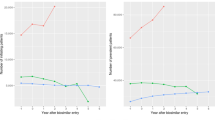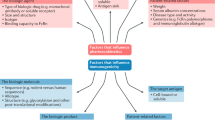Abstract
Patents for many key biological agents will soon expire. Third-party companies are, therefore, in the process of developing their own versions, termed biosimilar agents, of these innovator products. However, manufacture of biosimilar agents is complicated by the requirement for their production in biological systems, small variations in which can influence the structure, activity and metabolism of the biosimilar product. The development of biosimilar therapies for the treatment of patients with rheumatic diseases could potentially result in substantial cost savings for patients and health care providers, and consequently, increased availability of effective therapies. However, legislation that regulates the manufacture, registration and approval of biosimilar therapies varies considerably between different countries. In addition, major safety and efficacy concerns must be addressed before a rheumatologist can routinely substitute an innovator pharmaceutical with a biosimilar product.
This is a preview of subscription content, access via your institution
Access options
Subscribe to this journal
Receive 12 print issues and online access
$209.00 per year
only $17.42 per issue
Buy this article
- Purchase on Springer Link
- Instant access to full article PDF
Prices may be subject to local taxes which are calculated during checkout

Similar content being viewed by others
References
Hyrich, K. L. et al. Outcomes after switching from one anti-tumor necrosis factor α agent to a second anti-tumor necrosis factor α agent in patients with rheumatoid arthritis: results from a large UK national cohort study. Arthritis Rheum. 56, 13–20 (2007).
Patent status information—register entry for European Patent 0343684. Intellectual Property Office [online] (2009).
Patent status information—register entry for European Patent 0409607 Intellectual Property Office [online] (2009).
US$54 billion worth of biosimilar patents expiring before 2020. Generics and Biosimilars Initiative Online [online], (2011).
Medtrack [online], (2012).
Publications Office of the European Union. Council Regulation (EEC) No 1768/92 of 18 June 1992 concerning the creation of a supplementary protection certificate for medicinal products. EUR-Lex [online], (1992).
Castanheira, L. G., Barbano, D. B. & Rech, N. Current development in regulation of similar biotherapeutic products in Brazil. Biologicals 39, 308–311 (2011).
Brockhaus, M. et al. Human TNF receptor fusion protein. US Patent 8,063,182 (1995).
Medco Health Solutions, Inc. Estimated dates of possible first time generic/ Rx-to-OTC market entry. Medco [online], (2012).
Kay, J. Biosimilars: a regulatory perspective from America. Arthritis Res. Ther. 13, 112 (2011).
US Food and Drug Administration. Guidance for Industry. Biosimilars: questions and answers regarding implementation of the Biologics Price Competition and Innovation Act of 2009. Department of Health & Human Services [online], (2012).
Dranitsaris, G., Amir, E. & Dorward, K. Biosimilars of biological drug therapies: regulatory, clinical and commercial considerations. Drugs 71, 1527–1536 (2011).
Woodcock, J. et al. The FDA's assessment of follow-on protein products: a historical perspective. Nat. Rev. Drug Discov. 6, 437–442 (2007).
McCamish, M. & Woollett, G. Worldwide experience with biosimilar development. MAbs 3, 209–217 (2011).
Mellstedt, H., Niederwieser, D. & Ludwig, H. The challenge of biosimilars. Ann. Oncol. 19, 411–419 (2008).
Schiestl, M. et al. Acceptable changes in quality attributes of glycosylated biopharmaceuticals. Nat. Biotechnol. 29, 310–312 (2011).
International Conference on Harmonisation of Technical Requirements for Registration of Pharmaceuticals for Human Use. ICH harmonised tripartite guideline: comparability of biotechnological/biological products subject to changes in their manufacturing process Q5E. ICH harmonisation for better health [online], (2004).
Committee for Medicinal Products for Human Use. Guideline on similar biological medicinal products. European Medicines Agency [online], (2005).
Committee for Medicinal Products for Human Use. Guideline on similar biological medicinal products containing biotechnology-derived proteins as active substance: non-clinical and clinical issues. European Medicines Agency [online], (2006).
Liang, C. & Wang, J. China's perspective on similar biotherapeutic products. Biologicals 39, 312–316 (2011).
Knezevic, I. & Griffiths, E. Biosimilars—global issues, national solutions. Biologicals 39, 252–255 (2011).
Schellekens, H. & Moors, E. Clinical comparability and European biosimilar regulations. Nat. Biotechnol. 28, 28–31 (2010).
Committee for Medicinal Products for Human Use. Guideline on similar biological medicinal products containing monoclonal antibodies. Draft. European Medicines Agency [online], (2010).
Committee for Medicinal Products for Human Use. Concept paper on the revision of the guideline on similar biological medicinal products containing biotechnology-derived proteins as active substance: non-clinical and clinical issues. European Medicines Agency [online], (2011).
Barosi, G. et al. Key concepts and critical issues on epoetin and filgrastim biosimilars. A position paper from the Italian Society of Hematology, Italian Society of Experimental Hematology, and Italian Group for Bone Marrow Transplantation. Haematologica 96, 937–942 (2011).
US Food and Drug Administration. FDA HR 3590—686. Patient Protection and Affordable Care Act. Title VII—Improving access to innovative medical therapies. Subtitle A—Biologics price competition and innovation. Sec. 7002. Approval pathway for biosimilar biological products. US Department of Health & Human Services [online], (2010).
US Food and Drug Administration. Regulatory information. Sec. 505. [21 USC §355] New Drugs. US Department of Health & Human Services [online], (2009).
Kozlowski, S., Woodcock, J., Midthun, K. & Sherman, R. B. Developing the nation's biosimilars program. N. Engl. J. Med. 365, 385–388 (2011).
Kessler, M., Goldsmith, D. & Schellekens, H. Immunogenicity of biopharmaceuticals. Nephrol. Dial. Transplant. 21 (Suppl. 5), v9–v12 (2006).
Health Canada Health Products and Food Branch. Guidance for sponsors: information and submission requirements for subsequent entry biologics (SEBs) Health Canada [online], (2010).
World Health Organization Expert Committee on Biological Standardization. Guidelines on evaluation of similar biotherapeutic products (SBPs). World Health Organization [online], (2009).
Núñez, H. Y. et al. The regulatory framework for similar biotherapeutic products in Cuba. Biologicals 39, 317–320 (2011).
Jailing, D. Xian Janssen launches Remicade in China. PharmAsia News [online], (2007).
Maity, S. et al. A non-innovator version of etanercept for treatment of arthritis. Biologicals. 39, 384–395 (2011).
Malhotra, H. Biosimilars and non-innovator biotherapeutics in India: an overview of the current situation. Biologicals 39, 321–324 (2011).
Dr Reddy's launches Rituxan generic. FDC alerts [online], (2007).
BioXpress therapeutics biosimilar pipeline. bioXPRESS Therapeutics SA [online], (2011).
Author information
Authors and Affiliations
Contributions
Both authors contributed equally to researching the data for the article, writing the manuscript, discussions of its content, and review and editing of the manuscript before submission.
Corresponding author
Ethics declarations
Competing interests
The authors declare no competing financial interests.
Rights and permissions
About this article
Cite this article
Scheinberg, M., Kay, J. The advent of biosimilar therapies in rheumatology—“O Brave New World”. Nat Rev Rheumatol 8, 430–436 (2012). https://doi.org/10.1038/nrrheum.2012.84
Published:
Issue Date:
DOI: https://doi.org/10.1038/nrrheum.2012.84
This article is cited by
-
Real-world patient characteristics and use of disease-modifying anti-rheumatic drugs in patients with rheumatoid arthritis: a cross-national study
Clinical Rheumatology (2023)
-
Effective serum level of etanercept biosimilar and effect of antidrug antibodies on drug levels and clinical efficacy in Chinese patients with ankylosing spondylitis
Clinical Rheumatology (2019)
-
Neufassung der Stellungnahme der DGRh zu Biosimilars – Update 2017
Zeitschrift für Rheumatologie (2018)
-
Perception of Originator Biologics and Biosimilars: A Survey Among Belgian Rheumatoid Arthritis Patients and Rheumatologists
BioDrugs (2017)
-
Switching Between Reference Biologics and Biosimilars for the Treatment of Rheumatology, Gastroenterology, and Dermatology Inflammatory Conditions: Considerations for the Clinician
Current Rheumatology Reports (2017)



